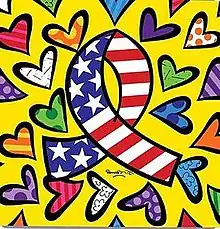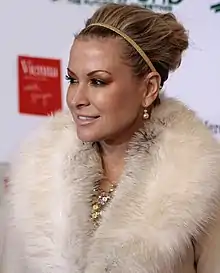What More Can I Give
"What More Can I Give" (also "Todo Para Ti" in Spanish) is a song written by American singer Michael Jackson and recorded in 2001 by Jackson and a supergroup of singers following the September 11 attacks. The inspiration for the song had initially come to Jackson after a meeting with the President of South Africa Nelson Mandela in the late 1990s. The song was to be premiered at a Jackson concert, but the singer failed to perform it. The song also failed to gain an official release, despite the pop singer having stated that it would be issued as a charity single for the refugees of the Kosovo War, which ended in 1999.
| "What More Can I Give" | ||||
|---|---|---|---|---|
 | ||||
| Single by Michael Jackson and the All Stars | ||||
| Released |
| |||
| Recorded | September 1999 – November 2001 | |||
| Genre | ||||
| Length |
| |||
| Label | ||||
| Songwriter(s) |
| |||
| Producer(s) | Michael Jackson | |||
| Michael Jackson singles chronology | ||||
| ||||
Following the September 11 attacks in 2001, Jackson rewrote "What More Can I Give" at the suggestion of Marc Schaffel. Schaffel, who produced and became the executive producer on the project, convinced Jackson to also do a Spanish version of the song as well, and handled the details of the production. Jackson and other artists recorded the new version of the song shortly afterward; the other artists included Mariah Carey, Reba McEntire, Anastacia, Nick Carter, 3LW, Beyoncé, NSYNC, Celine Dion, Boyz II Men members Shawn Stockman & Michael McCary, Brian McKnight, Luther Vandross, and Usher. In addition, a Spanish language version of the song was recorded. Entitled "Todo Para Ti", the lyrics were adapted into Spanish by the Panamanian musician Rubén Blades. Schaffel brought three-time Grammy winner K. C. Porter on to the project to give the Spanish version a different sound from the English recording.
"What More Can I Give" was scheduled for release as a charity single in the hope that $50 million would be raised between downloads, sponsors, and donations to aid the survivors and the families of victims of the September 11 terrorist attacks. The plan, however, never came to fruition and the reasons why have varied between sources and the individuals involved. One newspaper stated that the release of the song was abandoned after part of a marketing ploy by Sony Music after Jackson started a public campaign against Sony and its USA music head.
"What More Can I Give" was played on the radio for the first time in late 2002. The debut airing was made without permission by radio station WKTU-FM in New York. The following year, on October 27, 2003, "What More Can I Give" was made available to the public by way of digital download for several days. Jackson had the song taken down on November 17, on the eve of the raid on his Neverland Valley Ranch property by Santa Barbara Sheriffs. Proceeds from the short sale of the song went to children's charities.
Schaffel enlisted friend and famed Brazilian artist Romero Britto to design, create, and paint an artwork to be used as the cover for the single. Britto created the "ribbon" piece in bright colors including yellow, blue and red. Britto created 250 of this piece as a special collector's item and both Britto and Michael Jackson signed and numbered each of these pieces.
Michael Jackson recorded the song in both English and Spanish, and shot the video for Marc Schaffel. Even after his death it is believed to be the "last" actual completed song and video that Michael Jackson had done, and approved for release. It was also one of only a few tracks Michael Jackson ever performed in Spanish and is considered the last. Michael Jackson had told many people he felt that "What More Can I Give" was a definite contender for song of the year for both the English and Latin Grammys, and felt it would be as successful as "We Are the World". No official release date for either project has been given since the death of Jackson in June 2009, by either Schaffel or Jackson's estate.
Background and writing
Michael Jackson originally started writing the song, originally titled "Heal L.A.", with Brad Buxer after the Rodney King verdict and following riots in 1992. The song was worked on throughout the making of the HIStory: Past, Present and Future, Book I album and its subsequent world tour in 1996 to 1997. In late 1997, when work began on the Invincible album the song was put on hold, but its completion was always a passion of Michael's. Jackson was inspired to finish "Heal L.A." after a meeting with anti-apartheid activist and President of South Africa Nelson Mandela in 1999.[1][2] The songwriter stated that during a conversation with the then-President, the concept of giving was discussed by the pair. The singer revealed that it was during this interaction that the words "what more can I give" came into his mind and he began writing. With the first version of the song completed, Jackson intended to premiere it at his MJ & Friends concerts, staged in Munich, Germany and the South Korean capital Seoul in June 1999. Ultimately, Jackson did not perform the song at the concerts and it remained unreleased.[3]
"What More Can I Give" was also intended to be released as a charity single to aid the Kosovar refugees who had been forced out of their home during the Kosovo War (1998–1999). Jackson revealed his intentions for the release in an interview with the British tabloid newspaper the Daily Mirror. The pop singer stated that television footage of the war upset him and that he wanted to go to Yugoslavia to hug every one of the suffering children.[4][5] Like before, however, the song failed to gain a release as a single and was not considered good enough for inclusion on Jackson's 2001 Invincible album.[6][7]
In 2001, two separate concerts were held on September 7 and September 10 in celebration of Michael Jackson's thirtieth year as a solo entertainer (his first solo single, "Got to Be There", was released in 1971). Held in New York City, the shows sold out within five hours of going on sale. The concerts featured performances by artists such as Usher, Whitney Houston, Mýa, Liza Minnelli, James Ingram, Gloria Estefan and Marc Anthony. They also contained solo performances by Jackson himself, and marked the onstage reunion of the pop singer and his brothers (The Jacksons).[8]
Hours following the second concert, the attacks on the World Trade Center in New York City, the Pentagon outside of Washington, D.C., and a crash near Shanksville, Pennsylvania, resulted in the loss of 2,993 lives.[9][10] Following the events of September 11, Jackson rewrote "What More Can I Give" and expressed his views on the song, writing and music. "I'm not one to sit back and say, 'Oh, I feel bad for what happened to them[...] I want the whole world to sing ["What More Can I Give"], to bring us together as a world, because a song is a mantra, something you repeat over and over. And we need peace, we need giving, we need love, we need unity."[11]
Recording
"What More Can I Give" was recorded in 2001 by a number of artists, mainly pop. The project had received an "overwhelming response from major artists all over the world", with musicians such as Anastacia, Beyoncé, Nick Carter, Aaron Carter, NSYNC and Carlos Santana offering to lend their voices to the track. The recording process was held in Los Angeles, California and destinations reachable by Michael Jackson's private plane and mobile production unit headed by Marc Schaffel, who traveled across the globe with a team to record the different artists. The all-star benefit followed a similar Jackson-effort, "We Are the World", which raised millions of dollars for famine relief in Africa.[12][13] The recording of "What More Can I Give" was completed in October 2001.[14]
In addition to the English-language version of "What More Can I Give", a Spanish version of the song was recorded. Entitled "Todo Para Ti", the track features several of the musicians on the English version, as well as Latin artists such as Alejandro Sanz and Cristian Castro, who only appear on the Spanish-language version.[15][16] The title for "Todo Para Ti" translates to "Everything for You" in English. Producer and songwriter K. C. Porter had directly translated the title of "What More Can I Give" initially, but it was changed after Jackson expressed that he felt it was too clumsy.[17]
The All Stars


| Artist | Appears on English version | Appears on Spanish version |
|---|---|---|
| 3LW | Yes | No |
| Aaron Carter | Yes | No |
| Alejandro Sanz | No | Yes |
| Anastacia | Yes | Yes |
| Beyoncé | Yes | No |
| Billy Gilman | Yes | No |
| Brian McKnight | Yes | Yes |
| Bryton James | Yes | No |
| Carlos Santana | Yes | Yes |
| Celine Dion | Yes | Yes |
| Cristian Castro | No | Yes |
| Gloria Estefan | Yes | Yes |
| Hanson | Yes | No |
| Jon Secada | Yes | Yes |
| Joy Enriquez | No | Yes |
| Juan Gabriel | No | Yes |
| Julio Iglesias | No | Yes |
| Justin Timberlake | Yes | No |
| Laura Pausini | No | Yes |
| Luis Miguel | No | Yes |
| Luther Vandross | Yes | Yes |
| Mariah Carey | Yes | Yes |
| Michael McCary | Yes | No |
| Mýa | Yes | Yes |
| *NSYNC | Yes | No |
| Nick Carter | Yes | No |
| Olga Tañón | No | Yes |
| Reba McEntire | Yes | No |
| Ricky Martin | Yes | Yes |
| Rubén Blades | No | Yes |
| Shakira | Yes | Yes |
| Shawn Stockman | Yes | No |
| Thalía | Yes | Yes |
| Tom Petty | Yes | No |
| Usher | Yes | No |
| Ziggy Marley | Yes | No |
Live performance
"What More Can I Give" was performed live at the 9/11 benefit concert United We Stand: What More Can I Give. Held at the Robert F. Kennedy Memorial Stadium in Washington, D.C. on October 21, 2001, the eight-hour concert featured numerous artists performing to a sell-out audience of 54,000 people. Jackson performed his song "Man in the Mirror", before he and other singers such as Rod Stewart, Al Green, James Brown, Sean Combs and Pink closed the show with "What More Can I Give."[16] Joe D'Angelo of MTV later stated that the entire performance was held together by Jackson and Billy Gilman, who he claimed were the only two who looked like they knew the lyrics to the song. He concluded that the collective rendition of the song was altogether "choppy and disparate."[18] Jon Pareles also wrote negatively about the performance. He stated that it "became a shambles as [a] stageful of guests missed their cues or couldn't be heard".[19]
Jackson's appearance during the "What More Can I Give" performance was later edited out of American Broadcasting Company's airing of the show. The company were forced to take the action after representatives of Jackson informed them that CBS had demanded that the singer not perform on a network show before a Jackson special being broadcast on their channel the following month. CBS executives, however, denied their insistence on Jackson's removal from the footage. They stated that if the singer had appeared in the broadcast footage, they most probably would have been forced to delay Jackson's show, so that it would not appear too soon after the airing of United We Stand: What More Can I Give.[20]
Planned release as a physical single
Michael Jackson, 2001[21]
"What More Can I Give" had been planned for release as a charity single to aid survivors and families of victims of the September 11 terrorist attacks.[1] At the time of the attacks, Jackson stated that he hoped to raise $50 million for those affected.[6] It was also proclaimed by Jackson's spokesman that the recording would be released as soon as possible, with further reports revealing that it could be made available in music stores within that month.[12][22]
After the song failed to gain an official release, differing allegations arose as to who was to blame. Michael Jackson began a very public spat with Sony over the release of his then scheduled "Invincible" album.
Airplay
One year after the all-star recording of "What More Can I Give", it was played for the first time on radio. WKTU-FM, a radio station based in New York, debuted the song without permission and played it in heavy rotation. WKTU-FM's Program Director Frankie Blue stated at the time, "This song is a gift to the world. Michael and everyone donated their time for it, and it deserves to be heard. The song is called "What More Can I Give", and I can give the world a song they can cling onto and hopefully make them think about what they can give."[23] It is unknown how the station acquired a copy of the song; both Jackson and Schaffel were uninvolved with it. Prior to the airing, at least 200 promo copies of the song were sent to the musicians who participated in the recording process, as well as to their representatives. Schaffel stated that he would hate to see the song not being used to raise money for charity, the intended purpose. WKTU-FM received numerous telephone calls and emails from listeners following their unauthorized playing of the song, thanking the station and asking where they could buy a copy of "What More Can I Give".[23]
Release as a digital single
"What More Can I Give" was eventually made available as a digital download on October 27, 2003. The websites whatmorecanigive.com and musicforgiving.com sold the song at a price of $2 per download, with a portion of the proceeds from the fee going towards children's charities such as Oneness, Mr. Holland's Opus Foundation and the International Child Art Foundation.[24] The charities support arts programs to eliminate racism, increase education and connect children throughout the world, respectively. The download project had been set up by Jackson with the American media company Clear Channel Communications.[25]
Music video
The music video premiered at the 2003 Radio Music Awards; it features the song's artists (The All Stars) recording the track.
See also
References
Footnotes
- "McEntire, Gilman Join Michael Jackson Recording". Country Music Television. September 26, 2001. Retrieved November 12, 2009.
- "Country beat: Alan Jackson, Lonestar, Hal Ketchum ..." MTV. October 5, 2001. Retrieved November 11, 2009.
- Halstead, p. 351
- "Jackson rejects abuse allegations". BBC News. April 13, 1999. Retrieved November 12, 2009.
- "Pop star's latest song is dedicated to refugees". Deseret News. April 13, 1999. Archived from the original on January 2, 2013. Retrieved November 12, 2009.
- Martens, Ellin (October 8, 2001). "People: Oct. 8, 2001". Time. Retrieved November 12, 2009.
- Friedman, Roger (October 13, 2001). "Jagger Exits Charity Show as Jacko Takes Over". Fox News. Archived from the original on October 23, 2012. Retrieved November 12, 2009.
- Grant, p. 218
- "The story of September 11". The Daily Telegraph. October 19, 2001. Retrieved November 13, 2009.
- Graham, Charlotte A. (September 11, 2009). "Never forget". Ada Evening News. Retrieved November 11, 2009.
- "This kind of thing could inspire a song". The Spokesman-Review. October 21, 2001. Retrieved November 12, 2009.
- Gunderson, Edna (September 16, 2001). "Michael Jackson writes, casts a benefit ballad". USA Today. Retrieved November 12, 2009.
- "Jackson plans record for attack victims". BBC News. September 17, 2001. Retrieved November 12, 2009.
- "Jackson completes charity single". BBC News. October 28, 2001. Retrieved November 12, 2009.
- Jackson, Michael. "What More Can I Give" song credits. Epic Records.
- Grant, pp. 220–221
- VanHorn, Teri (October 22, 2001). "'NSYNC Join Jackson's Charity Single; Mariah, Celine Sing In Spanish". MTV. Retrieved November 12, 2009.
- D'Angelo, Joe (October 22, 2001). "'NSYNC, Michael Jackson, P. Diddy, Mariah Stand United At D.C. Concert". MTV. Retrieved November 13, 2009.
- Pareles, Jon (October 23, 2001). "United They Stood, for an Awfully Long Time". The New York Times. Retrieved November 11, 2009.
- Carter, Bill (November 1, 2001). "At Jackson's Request, ABC Cuts A Song Out of a Concert Tape". The New York Times. Retrieved November 13, 2009.
- Singers raise money for relief fund by joining in ensemble efforts. Jet. October 8, 2001. Retrieved November 11, 2009.
- D'Angelo, Joe (September 17, 2001). "Jackson Taps Britney, More For Song To Help Terrorism Victims". MTV. Retrieved November 13, 2009.
- Moss, Corey (October 3, 2002). "Michael Jackson's 9/11 Single Hits Radio One Year Late". MTV. Retrieved November 13, 2009.
- Grant, p. 236
- Vineyard, Jennifer (October 29, 2003). "Michael Jackson's Troubled 9/11 Single Now A Charity Download". MTV. Retrieved November 13, 2009.
Bibliography